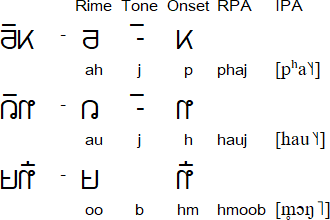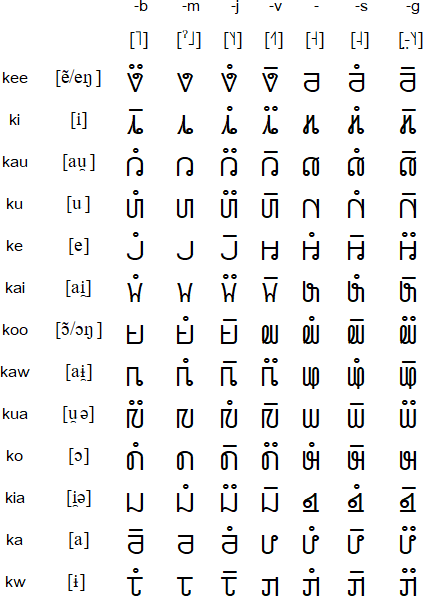The Pahawh Hmong alphabet was invented in 1959 by Shong
Lue Yang (![]() ), an illiterate Hmong farmer living in northern Laos close to the border with Vietnam. Shong Lue Yang believed that the alphabet was revealed to him by God, a belief shared by many among the Hmong.
), an illiterate Hmong farmer living in northern Laos close to the border with Vietnam. Shong Lue Yang believed that the alphabet was revealed to him by God, a belief shared by many among the Hmong.
Shong Lue Yang and his followers worked uncessingly to improve and disseminate his alphabet, and to bring about a revival of Hmong culture. In 1971 he was assassinated by government troops who were worried about his increasing influence.
Shong Lue Yang also created an alphabet for the Khmu language (a member of the Mon-Khmer family), but it never caught on and soon disappeared.
Hmong, a Hmong-Mien language spoken by about 2.6 million people in China, Vietnam, Laos, Thailand, USA, and French Guiana. There are two major varieties of Hmong: White Hmong (Hmoob Dawb) and Green/Blue Hmong (Moob Leeg/Hmoob Ntsuab), which are named after the traditional colours worn by women of the different groups.
Each syllable is written with three symbols: a rime, a tone marker and an onset. When reading, the onset comes first. The tone markers appear above the onsets. If there is no tone marker, the syllable has a middle tone. If there is no onset marker, the syllble begins with k. A null-onset marker is used to indicate syllables without an onset.
Here are some examples of how the syllables of the name of this script, Pahawh Hmong or Phajhauj Hmoob, are structured:

RPA = Romanized Popular Alphabet - see the Hmong language page for details.



Hear these numbers:
Download script charts for Pahawh Hmong (Excel)

Txhua tus neeg yug los muaj kev ywj pheej thiab sib npaug zos hauv txoj cai. Lawv xaj nrog lub laj thawj thiab lub siab thiab ib leeg yuav tsum coj ua ke ntawm ib leeg ntawm txoj kev ua kwv tij.
/tsʰuə˧ tu˩ neŋ˧˩̤ ʝu˧˩̤ lɒ˩ muə˥˧ ke˧˧˦ ʝɨ˥˧ pʰeŋ˥˧ tʰiə˦ ʂi˦ ᵐbau˧˩̤ ʐɒ˩ hau˧˦ tsɒ˥˧ cai˧. Laɨ˧˦ sa˥˧ ᶯɖɒ˧˩̤ lu˦ la˥˧ tʰaɨ˥˧ tʰiə˦ lu˦ ʂiə˦ tʰiə˦ i˦ leŋ˧˩̤ ʝuə˧˦ tʂu˩̰ cɒ˥˧ uə˧ ke˧ ⁿdaɨ˩̰ i˦ leŋ˧˩̤ ⁿdaɨ˩̰ tsɒ˥˧ ke˧˧˦ uə˧ kɨ˧˦ ti˥˧./
All human beings are born free and equal in dignity and rights. They are endowed with reason and conscience and should act towards one another in a spirit of brotherhood.
(Article 1 of the Universal Declaration of Human Rights)
This is an introduction to the Pahawh Hmong alphabet in Hmong
Information about: Hmong | Hmong Dau | Hmong Njua | Scripts for Hmong: Pahawh Hmong | Romanized Popular Alphabet | Pollard Miao | Nyiakeng Puachue Hmong | Phrases in: Hmong Dau | Numbers in: Hmong Dau | Iu Mien | Tower of Babel in: Hmong Dau | Hmong Njua | Iu Mien | Books about Hmong
Information about the Hmong language and people
http://en.wikipedia.org/wiki/Hmong_language
https://www.ethnologue.com/language/hmn
http://www.hmongnet.org
http://www.sytra.cn/hmong-translation-services.html
http://www.evertype.com/standards/iso10646/pdf/hmong.pdf
Online Hmong dictionary
http://www.HmongDictionary.com
Pahawh Hmong fonts
http://www.reocities.com/jglavy/hmong.html
Hmong Language Institute of Minnesotta
http://www.pahauhhmong.org
Hmong Nationality Archives
http://www.hmongarchives.org
Center for Hmong Studies, Concordia University, Saint Paul
http://www.csp.edu/hmongcenter/
A-Hmao, Dananshan Miao, Hmong, Hmong Dau, Hmong Njau, Hmu, Iu Mien, Luobohe Miao, Mashan Miao, She, Xong
Ahom, Aima, Arleng, Badagu, Badlit, Basahan, Balinese, Balti-A, Balti-B, Batak, Baybayin, Bengali, Bhaiksuki, Bhujimol, Bilang-bilang, Bima, Blackfoot, Brahmi, Buhid, Burmese, Carrier, Chakma, Cham, Cree, Dehong Dai, Devanagari, Dham Lipi, Dhankari / Sirmauri, Ditema, Dives Akuru, Dogra, Ethiopic, Evēla Akuru, Fox, Fraser, Gond, Goykanadi, Grantha, Gujarati, Gunjala Gondi, Gupta, Gurmukhi, Halbi Lipi, Hanifi, Hanuno'o, Hočąk, Ibalnan, Incung, Inuktitut, Jaunsari Takri, Javanese, Kaithi, Kadamba, Kamarupi, Kannada, Kawi, Kharosthi, Khema, Khe Prih, Khmer, Khojki, Khudabadi, Kirat Rai, Kōchi, Kodava Lipi, Komering, Kulitan, Kurukh Banna, Lampung, Lanna, Lao, Lepcha, Limbu, Lontara/Makasar, Lota Ende, Magar Akkha, Mahajani, Malayalam, Meitei (Modern), Manpuri (Old), Marchen, Meetei Yelhou Mayek, Meroïtic, Masarm Gondi, Modi, Mon, Mongolian Horizontal Square Script, Multani, Nandinagari, Newa, New Tai Lue, Ojibwe, Odia, Ogan, Pahawh Hmong, Pallava, Phags-pa, Purva Licchavi, Qiang / Rma, Ranjana, Rejang (Kaganga), Sasak, Savara, Satera Jontal, Shan, Sharda, Sheek Bakrii Saphaloo, Siddham, Sinhala, Sorang Sompeng, Sourashtra, Soyombo, Sukhothai, Sundanese, Syloti Nagri, Tagbanwa, Tai Noi, Takri, Tamil, Tanchangya (Ka-Pat), Tani, Thaana, Telugu, Thai, Tibetan, Tigalari, Tikamuli, Tocharian, Tolong Siki, Vatteluttu, Warang Citi
Page last modified: 07.11.23
[top]
You can support this site by Buying Me A Coffee, and if you like what you see on this page, you can use the buttons below to share it with people you know.

If you like this site and find it useful, you can support it by making a donation via PayPal or Patreon, or by contributing in other ways. Omniglot is how I make my living.
Note: all links on this site to Amazon.com, Amazon.co.uk
and Amazon.fr
are affiliate links. This means I earn a commission if you click on any of them and buy something. So by clicking on these links you can help to support this site.
[top]